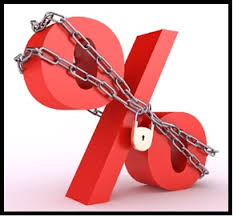The interest rate on a fixed-rate loan remains constant for the course of the loan. The loan payment should not fluctuate each month because the rate will be the same during the whole period, making it a reasonably low-risk loan. Take note of whether or not loans have fixed rates as you compare loan possibilities. Discover how these loans function so you may pick the one that best suits your needs.
A Fixed Interest Rate: What Is It?
A fixed rate is an interest rate that stays the same for the duration of a loan. For instance, the interest rate on a 30-year fixed-rate mortgage remains constant for the whole term. The interest rate is used to calculate your monthly loan payment. As a result, locking in the rate results in a consistent principal and interest payment each month. Loans can generally be divided into two categories: fixed and variable. Even though the interest rate may be fixed for a number of years at the start of your loan, variable-rate loans have an interest rate that may alter over time. These rates are built using a spread and an international rate known as LIBOR. These variable rates can rise or fall along with LIBOR as market conditions throughout the world change. Your monthly payment on a variable-rate loan could increase when rates climb, sometimes significantly With a fixed-rate loan, your monthly responsibility shouldn't alter over time, but your loan payment might. For instance, the amount of your mortgage payment may change if you combine property taxes and insurance fees.A Fixed-Rate Loan's Operation
When you take out a loan with a fixed rate, your lender determines the interest rate. This rate is determined by factors like your credit history, financial situation, and loan specifics. If the rate is fixed, it won't change during the course of your loan, regardless of how the interest rate environment in general changes. Your interest rate affects your required monthly payment in part. All other factors being equal, a higher rate translates into a larger monthly payment. For instance, the monthly payment on a $20,000 loan with a four-year term and a 10% interest rate is $507.25. However, at a 15% APR, the monthly payment rises to $556.61. With a flat payment over a predetermined period of years, fixed-rate loan installments lower your loan balance and stabilize your interest rates. With a fixed-rate loan, your loan balance would be zero at the conclusion of the period, much like with a 30-year mortgage or a four-year auto loan.Fixed-rate loan benefits and drawbacks
Although fixed-rate loans are typically safer than variable-rate loans, the steadiness they offer comes at a cost. In the end, you must determine what you are comfortable with and what you anticipate the future direction of interest rates to be. Pros- Consistent monthly payments over the duration of your loan.
- You must know the actual interest rate you will incur.
- No chance of future interest rate increases causing "payment shock"
- It often has a higher starting rate than loans with variable rates.
- If interest rates decline, you must refinance or accept a higher rate.
- For urgent needs, it might not be as effective.
Different Fixed-Rate Loan Types
A fixed interest rate is offered on many loans. These consist of:
- Loans for the purchase of a home: Typical mortgages, such as conventional 30-year and 15-year mortgages, have fixed rates.
- Home equity loans: The interest rate on a lump-sum home equity loan is often fixed. Although home equity lines of credit (HELOCs) frequently feature variable rates, it could be feasible to change the interest rate on your loan balance.
The interest rate on most auto loans is fixed.
- Student loans: The interest rates on federal student loans made after June 30, 2006, are fixed. Fixed or variable interest rates may be applied to private student loans.
- Personal loans: The interest rates on personal installment loans might be fixed or variable. Nevertheless, some of the most well-known providers of personal loans provide loans with set interest rates.
Make a Monthly Payment Calculation
The sum, length, and interest rate of a personal loan will determine your monthly payment (which is highly dependent on your credit score). By using the inputs below, you can get an idea of what your potential monthly payment would be. Cash Outlay $ 15,000 LENDER TERM 3 years (3 months) INTEREST RATE or Credit Score per cent. 15 OR Your FICO Rating MONTHLY PAYMENT $519.98 Interest is paid overall. $3,719.28 Sum borrowed $15,000.00Main points
- With fixed-rate loans, the interest rate is fixed and does not fluctuate.
- Your monthly payment shouldn't fluctuate because the rate is set.
- The possibility of payment shock from rising rates can be removed with a set rate.
- In general, the interest rate on fixed-rate loans is a little bit higher than the introductory rate on variable-rate loans.
- Fixed-rate loans might not be as appealing as variable-rate loans if interest rates decline.


